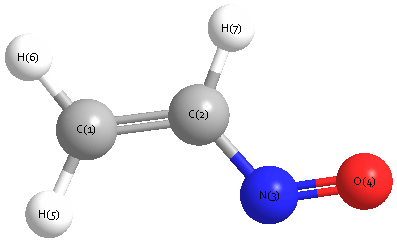Vibrational Frequencies calculated at HF/SDD
| Mode Number |
Symmetry |
Frequency
(cm-1) |
Scaled Frequency
(cm-1) |
IR Intensities
(km mol-1) |
Raman Act
(Å4/u) |
Dep P |
Dep U |
|---|
| 1 |
A' |
3476 |
3130 |
6.73 |
59.52 |
0.68 |
0.81 |
| 2 |
A' |
3400 |
3061 |
8.51 |
101.70 |
0.23 |
0.37 |
| 3 |
A' |
3362 |
3027 |
2.91 |
54.28 |
0.12 |
0.22 |
| 4 |
A' |
1824 |
1642 |
4.90 |
139.86 |
0.21 |
0.35 |
| 5 |
A' |
1751 |
1576 |
165.53 |
125.34 |
0.32 |
0.48 |
| 6 |
A' |
1564 |
1409 |
17.08 |
32.64 |
0.38 |
0.55 |
| 7 |
A' |
1412 |
1272 |
6.99 |
21.21 |
0.47 |
0.64 |
| 8 |
A' |
1276 |
1149 |
47.73 |
42.11 |
0.57 |
0.73 |
| 9 |
A' |
994 |
895 |
22.08 |
1.80 |
0.68 |
0.81 |
| 10 |
A' |
648 |
583 |
8.22 |
8.37 |
0.32 |
0.48 |
| 11 |
A' |
374 |
337 |
1.89 |
0.35 |
0.75 |
0.86 |
| 12 |
A" |
1180 |
1062 |
47.16 |
12.97 |
0.75 |
0.86 |
| 13 |
A" |
1106 |
996 |
50.31 |
3.98 |
0.75 |
0.86 |
| 14 |
A" |
763 |
687 |
3.21 |
9.43 |
0.75 |
0.86 |
| 15 |
A" |
195 |
176 |
0.03 |
0.89 |
0.75 |
0.86 |
Unscaled Zero Point Vibrational Energy (zpe) 11662.0 cm
-1
Scaled (by 0.9004) Zero Point Vibrational Energy (zpe) 10500.5 cm
-1
See section
III.C.1 List or set vibrational scaling factors
to change the scale factors used here.
See section
III.C.2
Calculate a vibrational scaling factor for a given set of molecules
to determine the least squares best scaling factor.
Charges, Dipole, Quadrupole and Polarizability
Charges from optimized geometry at HF/SDD
Charges (e)
| Number |
Element |
Mulliken |
CHELPG |
AIM |
ESP |
| 1 |
C |
-0.369 |
|
|
|
| 2 |
C |
-0.077 |
|
|
|
| 3 |
N |
0.070 |
|
|
|
| 4 |
O |
-0.290 |
|
|
|
| 5 |
H |
0.220 |
|
|
|
| 6 |
H |
0.212 |
|
|
|
| 7 |
H |
0.234 |
|
|
|
Electric dipole moments
Electric dipole components in Debye
(What's a Debye? See section
VII.A.3)
| |
x |
y |
z |
Total |
| |
1.761 |
3.543 |
0.000 |
3.957 |
| CHELPG |
|
|
|
|
| AIM |
|
|
|
|
| ESP |
|
|
|
|
Electric Quadrupole moment
Quadrupole components in D Å
| Primitive |
|---|
| | x | y | z |
|---|
| x |
-23.227 |
-0.639 |
0.000 |
| y |
-0.639 |
-24.358 |
0.000 |
| z |
0.000 |
0.000 |
-24.355 |
|
| Traceless |
|---|
| | x | y | z |
|---|
| x |
1.130 |
-0.639 |
0.000 |
| y |
-0.639 |
-0.567 |
0.000 |
| z |
0.000 |
0.000 |
-0.563 |
|
| Polar |
|---|
| 3z2-r2 | -1.125 |
|---|
| x2-y2 | 1.131 |
|---|
| xy | -0.639 |
|---|
| xz | 0.000 |
|---|
| yz | 0.000 |
|---|
|
Polarizabilities
Components of the polarizability tensor.
Units are
Å
3 (Angstrom cubed)
Change units.
| |
x |
y |
z |
| x |
6.747 |
2.634 |
0.000 |
| y |
2.634 |
5.352 |
0.000 |
| z |
0.000 |
0.000 |
1.904 |
<r2> (average value of r
2) Å
2
| <r2> |
77.178 |
| (<r2>)1/2 |
8.785 |
